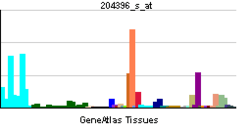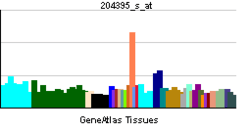GRK5
G protein-coupled receptor kinase 5 is an enzyme that in humans is encoded by the GRK5 gene.[1][2]
This gene encodes a member of the guanine nucleotide-binding protein (G protein)-coupled receptor kinase subfamily of the Ser/Thr protein kinase family. The protein phosphorylates the activated forms of G protein-coupled receptors thus initiating their deactivation. It has also been shown to play a role in regulating the motility of polymorphonuclear leukocytes (PMNs).[2]
References
- ↑ Kunapuli P, Benovic JL (Jul 1993). "Cloning and expression of GRK5: a member of the G protein-coupled receptor kinase family". Proc Natl Acad Sci U S A 90 (12): 5588–92. doi:10.1073/pnas.90.12.5588. PMC 46766. PMID 7685906.
- ↑ 2.0 2.1 "Entrez Gene: GRK5 G protein-coupled receptor kinase 5".
Further reading
- Bullrich F, Druck T, Kunapuli P et al. (1995). "Chromosomal mapping of the genes GPRK5 and GPRK6 encoding G protein-coupled receptor kinases GRK5 and GRK6.". Cytogenet. Cell Genet. 70 (3–4): 250–4. doi:10.1159/000134045. PMID 7789183.
- Kunapuli P, Gurevich VV, Benovic JL (1994). "Phospholipid-stimulated autophosphorylation activates the G protein-coupled receptor kinase GRK5". J. Biol. Chem. 269 (14): 10209–12. PMID 8144599.
- Kunapuli P, Onorato JJ, Hosey MM, Benovic JL (1994). "Expression, purification, and characterization of the G protein-coupled receptor kinase GRK5". J. Biol. Chem. 269 (2): 1099–105. PMID 8288567.
- Nagayama Y, Tanaka K, Hara T et al. (1996). "Involvement of G protein-coupled receptor kinase 5 in homologous desensitization of the thyrotropin receptor". J. Biol. Chem. 271 (17): 10143–8. doi:10.1074/jbc.271.17.10143. PMID 8626574.
- Oppermann M, Freedman NJ, Alexander RW, Lefkowitz RJ (1996). "Phosphorylation of the type 1A angiotensin II receptor by G protein-coupled receptor kinases and protein kinase C". J. Biol. Chem. 271 (22): 13266–72. doi:10.1074/jbc.271.22.13266. PMID 8662816.
- Fredericks ZL, Pitcher JA, Lefkowitz RJ (1996). "Identification of the G protein-coupled receptor kinase phosphorylation sites in the human beta2-adrenergic receptor". J. Biol. Chem. 271 (23): 13796–803. doi:10.1074/jbc.271.23.13796. PMID 8662852.
- Bonaldo MF, Lennon G, Soares MB (1997). "Normalization and subtraction: two approaches to facilitate gene discovery". Genome Res. 6 (9): 791–806. doi:10.1101/gr.6.9.791. PMID 8889548.
- Pronin AN, Carman CV, Benovic JL (1998). "Structure-function analysis of G protein-coupled receptor kinase-5. Role of the carboxyl terminus in kinase regulation". J. Biol. Chem. 273 (47): 31510–8. doi:10.1074/jbc.273.47.31510. PMID 9813065.
- Premont RT, Claing A, Vitale N et al. (1998). "beta2-Adrenergic receptor regulation by GIT1, a G protein-coupled receptor kinase-associated ADP ribosylation factor GTPase-activating protein". Proc. Natl. Acad. Sci. U.S.A. 95 (24): 14082–7. doi:10.1073/pnas.95.24.14082. PMC 24330. PMID 9826657.
- Carman CV, Lisanti MP, Benovic JL (1999). "Regulation of G protein-coupled receptor kinases by caveolin". J. Biol. Chem. 274 (13): 8858–64. doi:10.1074/jbc.274.13.8858. PMID 10085129.
- Brenninkmeijer CB, Price SA, López Bernal A, Phaneuf S (1999). "Expression of G-protein-coupled receptor kinases in pregnant term and non-pregnant human myometrium". J. Endocrinol. 162 (3): 401–8. doi:10.1677/joe.0.1620401. PMID 10467231.
- Okochi M, Walter J, Koyama A et al. (2000). "Constitutive phosphorylation of the Parkinson's disease associated alpha-synuclein". J. Biol. Chem. 275 (1): 390–7. doi:10.1074/jbc.275.1.390. PMID 10617630.
- Pronin AN, Morris AJ, Surguchov A, Benovic JL (2000). "Synucleins are a novel class of substrates for G protein-coupled receptor kinases". J. Biol. Chem. 275 (34): 26515–22. doi:10.1074/jbc.M003542200. PMID 10852916.
- Berrada K, Plesnicher CL, Luo X, Thibonnier M (2000). "Dynamic interaction of human vasopressin/oxytocin receptor subtypes with G protein-coupled receptor kinases and protein kinase C after agonist stimulation". J. Biol. Chem. 275 (35): 27229–37. doi:10.1074/jbc.M002288200. PMID 10858434.
- Zhou H, Yan F, Tai HH (2001). "Phosphorylation and desensitization of the human thromboxane receptor-alpha by G protein-coupled receptor kinases". J. Pharmacol. Exp. Ther. 298 (3): 1243–51. PMID 11504827.
- Blaukat A, Pizard A, Breit A et al. (2001). "Determination of bradykinin B2 receptor in vivo phosphorylation sites and their role in receptor function". J. Biol. Chem. 276 (44): 40431–40. doi:10.1074/jbc.M107024200. PMID 11517230.
- Hu LA, Chen W, Premont RT et al. (2002). "G protein-coupled receptor kinase 5 regulates beta 1-adrenergic receptor association with PSD-95". J. Biol. Chem. 277 (2): 1607–13. doi:10.1074/jbc.M107297200. PMID 11700307.
- Warabi K, Richardson MD, Barry WT et al. (2002). "Human substance P receptor undergoes agonist-dependent phosphorylation by G protein-coupled receptor kinase 5 in vitro". FEBS Lett. 521 (1–3): 140–4. doi:10.1016/S0014-5793(02)02858-2. PMID 12067742.
- Strausberg RL, Feingold EA, Grouse LH et al. (2003). "Generation and initial analysis of more than 15,000 full-length human and mouse cDNA sequences". Proc. Natl. Acad. Sci. U.S.A. 99 (26): 16899–903. doi:10.1073/pnas.242603899. PMC 139241. PMID 12477932.
| |||||||||||||||||||||||||||||||||||||||||||||||||||||||||||||||||||||||||||||||||||||||||||||||||||||||||||||||||||||||||||||||||||||||||||||||||||||||||||||||||

